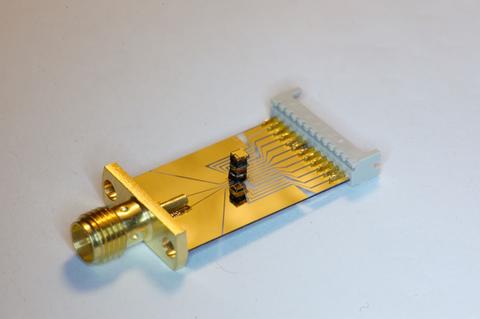Chip-Scale Atomic Magnetometers

The Technology
NIST scientists have developed inexpensive chip-scale magnetometers that sense very faint magnetic fields. An individual sensor consists of a vapor of atoms in a sealed glass vacuum chamber with a volume of about 1 cubic millimeter. The sensor units are low power and intended to be deployed in large arrays.
Each magnetometer detects changes in a tiny diode laser beam as it passes through a vapor of atoms such as rubidium. The laser light is polarized, aligned in one orientation. When the light interacts with the vapor, it causes the magnetic spins of the trapped atoms to also align. The laser beam then exits the vapor cell and hits a detector.
In the absence of a magnetic field, the atoms’ spins would stay lined up and the polarization of the laser beam would remain unchanged. But when a field is present, it changes the atoms’ spin by some amount. That, in turn, changes the polarization, and hence the amount, of the light entering the detector. The magnitude of that change is a sensitive and accurate measure of magnetic field strength.
Advantages Over Existing Methods
Many current high-end magnetic field measurement applications use superconducting quantum interference devices (SQUIDs), which must be cooled to cryogenic temperatures.
Unlike SQUIDs, the chip-scale NIST sensor operates at room temperature, making it available for medical applications, and it collects data in the form of light, which can be measured more exactly than any other physical property.
Applications
The chip-scale sensor is convenient and practical for biomedical applications. It can measure the weak magnetic fields from the brain and heart. Therefore, it’s potentially useful for monitoring fetal heartbeats and neurological conditions such as epilepsy.
Chip-scale atomic magnetometers may also provide new opportunities for space science. Their small size makes them suitable for the new generation of miniaturized, low-cost satellites called CubeSats, which can be as small as 10 centimeters (4 inches) on a side. Most CubeSats are monitoring Earth, but some have been deployed as far away as Mars. Their long-term stability and intrinsic accuracy can also be beneficial for electrical metrology, such as current sensing and stabilization.
Further progress is expected to enable deployment of the sensors in a wide range of places where their conventional counterparts cannot go. These devices could someday be placed in battery-powered mobile computers, wireless communications and GPS components, defense systems, and miniaturized sensors and calibration standards for the factory floor.
Key Papers
M. Gonzalez Maldonado, O. Rollins, A. Toyryla, J. A. McKelvy, A. Matsko, I. Fan, Y. Li, Y.-J. Wang, J. Kitching, I. Novikova, and E. E. Mikhailov. Sensitivity of a vector atomic magnetometer based on electromagnetically induced transparency. Optics Express. Published online June 26, 2024. DOI: 10.1364/OE.529276
J. A. McKelvy, I. Novikova, E. E. Mikhailov, M. A Maldonado, I. Fan, Y. Li, Y.-J. Wang, J. Kitching and A. B. Matsko. Application of kernel principal component analysis for optical vector atomic magnetometry. Machine Learning: Science and Technology. Published online Dec. 8, 2023. DOI: 10.1088/2632-2153/ad0fa4
J. Kitching. Chip-scale atomic devices. Applied Physics Reviews. Published online Aug. 14, 2018. DOI: 10.1063/1.5026238
R. Mhaskar, S. Knappe and J. Kitching. A low-power, high-sensitivity micromachined optical magnetometer. Applied Physics Letters. Published online Dec. 11, 2012. DOI: 10.1063/1.4770361
T.H. Sander, J. Preusser, R. Mhaskar, J. Kitching, L. Trahms and S. Knappe. Magnetoencephalography with a Chip-Scale Atomic Magnetometer. Biomedical Optics Express. Published April 17, 2012. DOI: 10.1364/BOE.3.000981
M.P. Ledbetter, I.M. Savukov, D. Budker, V. Shah, S. Knappe, J. Kitching, D.J. Michalak, S. Xu and A. Pines. Zero-field remote detection of NMR with a microfabricated atomic magnetometer. PNAS. Published Dec. 18, 2007. DOI: 10.1073/pnas.0711505105
V. Shah, S. Knappe, P.D.D. Schwindt and J. Kitching. Subpicotesla atomic magnetometry with a microfabricated vapour cell. Nature Photonics. Published online Nov. 1, 2007. DOI: 10.1038/nphoton.2007.201
P.D.D. Schwindt, B. Lindseth, S. Knappe, V. Shah, J. Kitching and L. Liew. Chip-scale atomic magnetometer with improved sensitivity by use of the Mx technique. Applied Physics Letters. Published online Feb. 21, 2007. DOI: 10.1063/1.2709532
P.D.D. Schwindt, S. Knappe, V. Shah, L. Hollberg, J. Kitching, L. Liew and J. Moreland. Chip-scale atomic magnetometer. Applied Physics Letters. Published Dec. 27, 2004. DOI: 10.1063/1.1839274
Key Patents
M.P. Ledbetter et al. Detection of J-coupling using atomic magnetometer. United States Patent US 9,140,657. Sept. 22, 2015.
J. Kitching et al. Atomic magnetometer and method of sensing magnetic fields. United States Patent US 8,334,690. Dec. 18, 2012.
M.P. Ledbetter et al. Integrated microchip incorporating atomic magnetometer and microfluidic channel for NMR and MRI. United States Patent US 7,994,783. Aug. 9, 2011.
J. Kitching et al. Compact atomic magnetometer and gyroscope based on a diverging laser beam. United States Patent US 7,872,473. Jan. 18, 2011.
L. Hollberg et al. Miniature frequency standard based on all-optical excitation and a micro-machined containment vessel. United States Patent US 6,806,784. Oct. 19, 2004.
Contacts
-
(303) 497-4083

